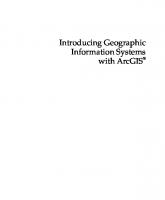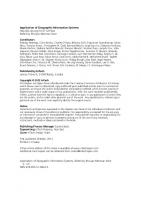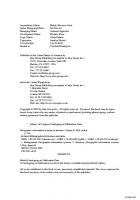GIS Fundamentals: A first text on Geographic information systems [7 ed.] 1593995520
PDF with OCR text recognition.
123 27 63MB
English Pages 746 Year 2022
Recommend Papers
File loading please wait...
Citation preview
GIS Fundamentals: A First Text on Geographic Information Systems 7th Edition
Paul Bolstad & Steven Manson University of Minnesota - Twin Cities
Eider Press \Vhite Bear Lake, M innesota
Et'rata.1.l.1.Stn1c1or resourm. aud othet helpful l.ttfonnation nbo\1111-t.is book may be found ai b1ip:/Jwww.paulbolstad.net/gisbook.b1ml. or at ,vww.paulbols1ad,org
GJS Funda.mcnmls: A firs11e:n on geographic infonnatfon S)'$lems. 7th edition.
Copyright (c) 1022 by Paul Bolstad, Steven Manson. all rig.his reserved. Printed in the United States ofAmerica. No pan of this bool.: may be teptoduc;ed fot dissem.in3tiou wi1bot11 pennissiou., excep1 for brief quotation in ,wiuen reviews.
Front cover: Tempera-rure.aQomalies on June 29, 202 1 for North America. showing the holiest temperntures ever r«:orded for Canada (deepest reds}. mare th.in 2G°C "hove normal. Coutlesy Goddard E:u'lh
Obsu,,s ...........- ,.......................................................... I 75 Tromfor111atio11 Equations ..................................................... 17$. A Ca11rfot1 Wiren Ew1lua1t}ig frgom ••.,............................................ 5J9 Ken,d .~fapp111g ..................................................................... $40 nme·Oeograpllic Demit)' Estimnh'ou .................................... 546 55(}
Su,111110,y .............................................................................. "
Chapter 13, Spatial Models and Modeling ....... 561 Introduction ........ ....... .......... ....... ....... ....... ....... ....... ... .. 561 C:inograpluc Modeling ........ ....... .............. ....... ............ 565 Des1g11i11g a Carrograpluc Model .......................................... 566 W€1ghtmgs and Ra11ki11gs ....................................................... 567
Ro11Jn11gs 1J-11l1t11 o ·,ror,o ....................................................... 568 Weighti11g Among Cntel'in ..................................................... 570 Cartogropluc Models: A .Detm'/ed £\ample .......................... 57J. Scnptu,g a11d ,,tlf Pro,cct}.
10
GIS Fundamentals
Figure- 1- IJ.: Ait pollu· tiQo from power pUnis o.ud vehicles is still a sia.oificanl bc-ahh hazard (couttciy M. Riyll ru~
II~ Stnt.e of C,hfonn:a).
improvements. Airpollu1ion shaves JO years off of1be life span of about 200.000 people
Reducing sickness and deatlt requires identifying areas of high expoStcre. particu-
in the United States each year. and is respon-
larly for \'lllnerable populations. Effective
sible for the death of7 million people worldwide each year. It also causes increased
managemen1 requires an es1lmate of how much a decrease in pollution will increase
sickne.ss. hospilalization. and medical costs
health. Scientists have focused o n these
Iha, annually reach in10 the billions of dollars. A reduc1ion in air pollution has been
questions over lhe past decades, and can map exposures both over broader areas and
shown to significantly reduce hospitaliz..1-
at increasing level of spatial detail.
1ion. childhood aslhma. and 10 increase life expectancy.
ellites. as the chemicals and p.1rt icles change
Air pollution may be mappeservatory as measuremeuts improved. ·1ec1onic pla1es shiftoo. and convention changed.
Asecoud angle of rotation. measured along north-south planes that intersect the
poles. is used to define a la1i1ude. Lalitudes are specified as zero at the Equator. u,e Line encircling 1he Ea11h that is equidistan1 from the North and Sou1h Poles. By convention, latitudes increase 10 maximum values of 90 degrees in the 11011h and south. or, if signed.
frnm -90 at 1he South Pole to 90 at 1he North Pole. Lines of constant la1itude are called parallels (Figure 2·6). Geographic coordimues do 001 fonn a Cartesian sys1em becaiise the meridians c,onverge. A Cartesian system defines lines
on a righi-:1ngJe, planar grid. Geographic coordina1es ocC11r on a curved surface. and the longitudinal lines cross at tbe poles. This convergence means the distance
spaimed by a degree of loogimde varies from approximately l 11 .3 kilorroeters at the
Equator. to Okilometers at the poles. In conltllSL 1he ground distance for a degree ofla1itude varies only slig)itly. from 110.6 kilomelers at the Equa1or to 111.7 kilome1ers a, the poles. The slight difference wilh la1in1de is due to a non-spherical Earth. something we'll describe a bit later. Convergenceca11ses distortin because a degree of latirude spans a grealer distance
near 1he poles than a degree of ingimde. For example. "circles" with a fixed radius in geographjc units, such as 5°, are not circles
011 tlie st1rfate of the globe, witli di~tortion grea1es1 at the poles (Figure 2·7. left). They may appear as circles when the Earth's sur.
face is ..unrolloo .. and ploned 011 a Oat map (Figure 2-7. right). b1111rea1ing spnerical coordinates (la1imdesllongitudes) as Cartesian coordfoates creales an inherently dis-
1orted map. NOie lhe distorted sbape of A.LHarctica in Figure 2-7. right.
Because the spherical sys1cm for geograpltic coordina1es is noo-Canesian. planar fommlas for area, distance, angles, and
olher geometric properties used in a Canesian coordinate system shou.ld not be used with geographic coordinates. Are.as are
usual!y calcula1ed after convening 10 a projec1ed sys1em. described in chap1er 3. There are two primary conventions
used for specifying latitude and loogimde (Figure 2-8). The first uses a leading letter. N. S, E, or IV, 10 indica1e direction, fof. lowed by a number 10 indicate location. Northern latitudes are preceded by an N and southern latitudes by an S, for exam-
ple. N90°. SI0°. Lougimde values are pre-
Chapter 2: Data Models
29
Roto-t1on axis at the geogr aphic Nor th Pote. ).•?, 4'•90
Porollels. Eost-West Geogroplic porlqln: )..0. 4' .o
lines of equol IOll!ude (,j,)
U1
fi&"rt- l-6: Cc:m,·eu1iom wben n:fc1Ting to geographic Ultitudes Md lo11gitudC$. Mcridian!i arc lines nllUting nortb-soutb tba1 ba,·c coustant looajrud«. ParalMs arc Imes: n.wning cast·WC61 lb:u ban: ~.Stant latitudes. Latirudc i:s ZC':f"O Olt 1bc Equator. Loniirude is zero on tbc Ottcnwicb Mcridi.,11111,d undci1.ncd at 1.hc poles. b,cc.,usc all longitlld-iual mcridi!l1'5 iJ1tc111a:1 1licn: (i. • ? in tbc figure).
F1;urt l -7: Gcoat9phic coordi.na.t« o" a spbcrie11I (left) aild Car1csian (ri,ht) rcprCklltati.on. Notice that ..circles'' dcfotcd by ll 5 d~c nridiwi do 1.ot forut circles on the E:uth 's SW'f:ncc nc11t 1hc polc-s, 11.t shown on thtsphcric.il representation (left figwc), but :ippca.r a, ci.rdc$ iu the dislorted Cn.ttcs:ian pie.I of gcogr,ip!i..ic coordi,. 11atcs (riaht), This figure illu!itratcs both that a) tbc sur!aoce disua:)Ce for a tmit of 1011.gitude changes depending on your location on Earth, a.iKi b) 11 Cat1c.s-Uln plot o( $C03N1phic coordinates is biahly dist01tcd.
30
GIS Fundamentals
ceded by an E or W, for example WitO". Longin1des range from Oto 180 degrees east or west. Note 1ba1 the east and west longitudes meet at 180 degrees. so that E 180° equals W 180°. Signed coordinates are 1he second common way to specify latitude and longitude.
North Pole
Nil0 , £84
--"P-~·11· OC:s.,.
Northern la1in1des are positive and southern latin1des are negative. and eastern longitudes positive and western longimdes negative. Latitudes vary from -90 degrees to 90 degrees. and longitudes vary from - ISO degrees to 180 degrees. By this com•ention. the longitudes "meel'' at the maximum and minimum values, so -180° equals t 80". Spheric.al geographic coordinates are often recorded in a degrees.minutes.seconds (OMS) notation: N43° 35' 20" for 43 degrees. 35 minutes. and 20 seconds of latitude. In OMS, each degree is made up of 60
minutes of arc. and e.acb minute is in mm
S62", E35 SOIJ1h Pote
·62' or.35..,
Fleurt 2-8: SpheriC;J1J coord.i1utc~ of Luimdc :lnd longitude 11.-re IUOtil often C:




![Environmental Modelling with GIS and Remote Sensing (Geographic Information Systems Workshop) [1 ed.]
9780415241700, 0415241707](https://ebin.pub/img/200x200/environmental-modelling-with-gis-and-remote-sensing-geographic-information-systems-workshop-1nbsped-9780415241700-0415241707.jpg)



![Introducing Geographic Information Systems with ArcGIS: A Workbook Approach to Learning GIS [3 ed.]
1118159802, 9781118159804](https://ebin.pub/img/200x200/introducing-geographic-information-systems-with-arcgis-a-workbook-approach-to-learning-gis-3nbsped-1118159802-9781118159804.jpg)
![Geographic Information Systems [1 ed.]
9781620819050, 9781612099255](https://ebin.pub/img/200x200/geographic-information-systems-1nbsped-9781620819050-9781612099255.jpg)
![GIS Fundamentals: A first text on Geographic information systems [7 ed.]
1593995520](https://ebin.pub/img/200x200/gis-fundamentals-a-first-text-on-geographic-information-systems-7nbsped-1593995520.jpg)